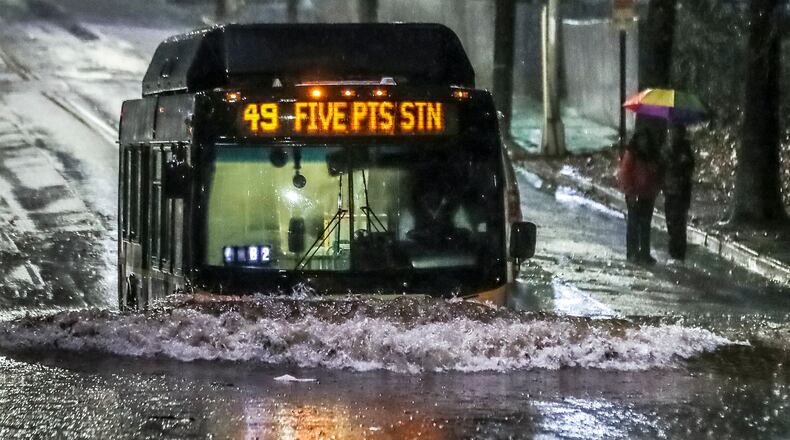The torrent of rain from Monday afternoon into Tuesday morning caused waves of problems all over Metro Atlanta. Immediately, as storms pushed into the western edge of the metro, the crash count and trip times started to rise. A tornado did some damage in Coweta County, but the overall impact of Tuesday’s weather round was far less than Wednesday’s.
Wednesday morning was an Atlanta traffic hellscape. Inches of rain poured down in buckets in the overnight hours, causing Atlantans to wake up to impassable roads and interstate capacities choked by growing water pools. WSB Triple Team Traffic did an incredible job detailing the major hassles.
The Atlanta Journal-Constitution photojournalist John Spink happened upon a MARTA bus with rising flood water up above its headlights and other cars halfway submerged in the Wednesday morning deluge. GDOT deployed HERO operators to multiple freeway flooding spots, fanning arrays of cones over swaths of submerged lanes to steer drivers away from peril.
And Roswell PD put the exclamation point on the chaos, with the oft-deployed and oft-ignored severe weather cliché: Turn around, don’t drown.
As the northern Fulton County city explained, just six inches of water can take control out of the hands of drivers or simply stall out vehicles. One foot of water can carry a small vehicle, and water two feet deep is enough to cause most autos to float.
Most people would likely agree that trying to push through two feet of water is a terrible idea. But actually knowing the depth of standing flood water is far less resolute.
That’s the key here. Driving in flood water is like trying not to drink too much: You are fine and can have another, until it is one too many. And then it is too late.
For driving in a downpour, there is simply no sense in venturing a vehicle through flood water. One driver on I-285/westbound (Outer Loop) near Ashford Dunwoody Road (Exit 29) told me they had to avoid a large pool of water in that work zone. This area is one of many that often flood first in heavy rain.
That driver told me that as they drove by they looked over and saw a few electric vehicles that had tried to sail across the pond and had stalled.
The margin for error in standing water is low enough in standard combustion vehicles, as just a few inches of water can mix with fuel, oil, engine components, and the car’s electrical tools to stall it out. That gray area is even thinner on all-electric cars, whose batteries are often beneath the car. Water and electronics mix even worse than a pen of donkeys and elephants.
Trying to venture through pools of road water not only risks the safety of that car and driver, but also others. Once police and fire units have to respond to these calls, the responders put themselves in more danger. Responding to drivers stranded in water also takes these rescue units away from other, less avoidable emergencies.
The end of November saw similar AM drive severe weather with the same kinds of results in floods. Bartow County’s decision during last week’s bout to delay its schools’ start time by two hours was a move that more school systems and employers should have considered. Travel in severe weather is dangerous, no matter who causes the crash or emergency.
But the need to travel is unavoidable at some inconvenient and unsavory times, so caution must always be the foot forward. But there are always a select few drivers who operate in a different mode. This couldn’t possibly happen to me. Then it does.
One such driver that I watched from the WSB Skycopter wised up in the middle of their bad decision on Azalea Drive in Roswell. That road floods out multiple times per year, because it is low-lying and right along the Chattahoochee River’s banks. This SUV driver ventured about a half-mile down the completely flooded and barricaded road, west of Highway 9, with water up to the top of its wheel wells. They got to a point where the water seemed to deepen and they finally began a U-turn to get out of there. We didn’t stay long enough to see if they made their way back to Willeo Road’s dry ground, but another “brave” driver was just behind them pushing through in the floods.
Turn around, don’t drown. It’s common sense.
Doug Turnbull, the PM drive Skycopter anchor for Triple Team Traffic on 95.5 WSB, is the Gridlock Guy. He also hosts a traffic podcast with Smilin’ Mark McKay on wsbradio.com. Contact him at Doug.Turnbull@cmg.com.
About the Author

